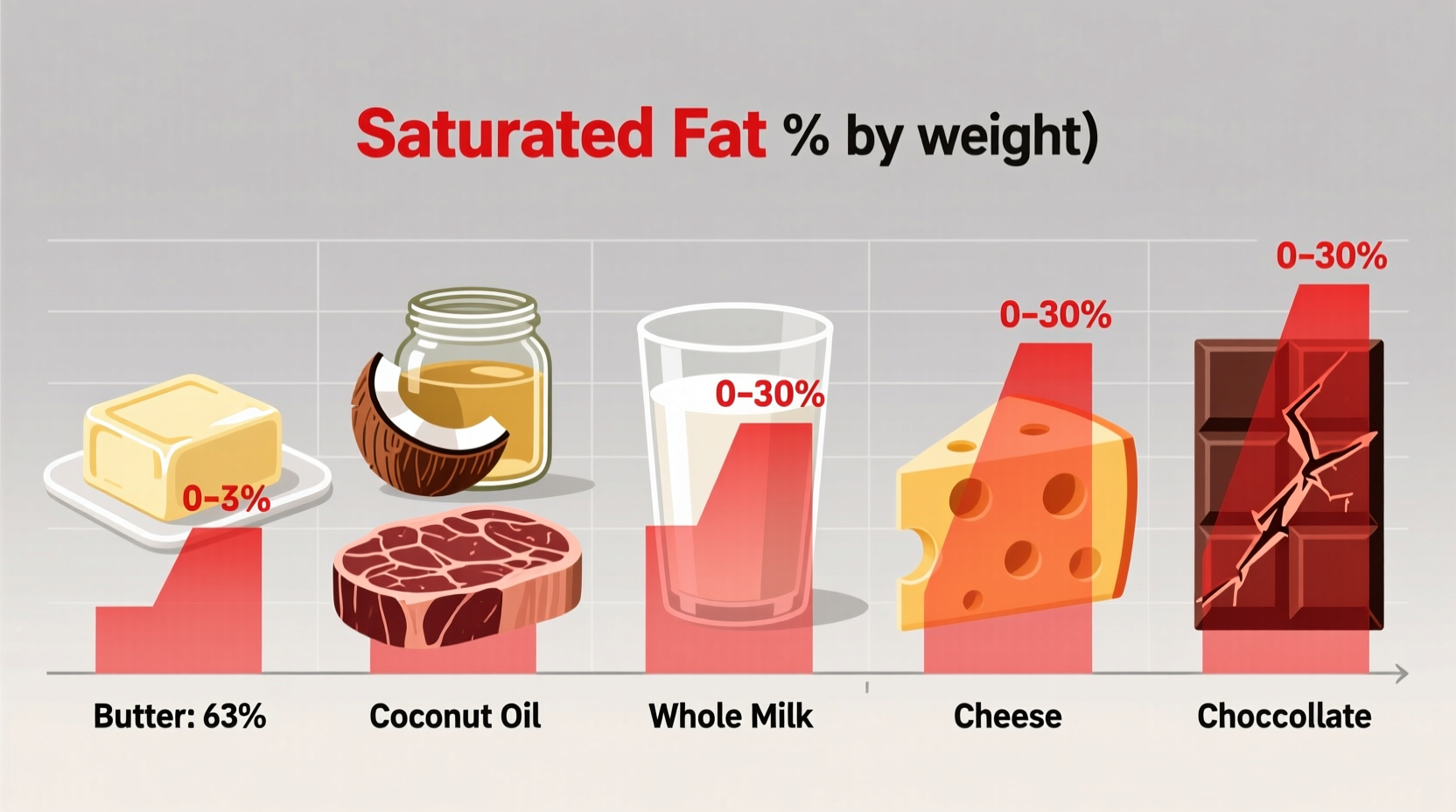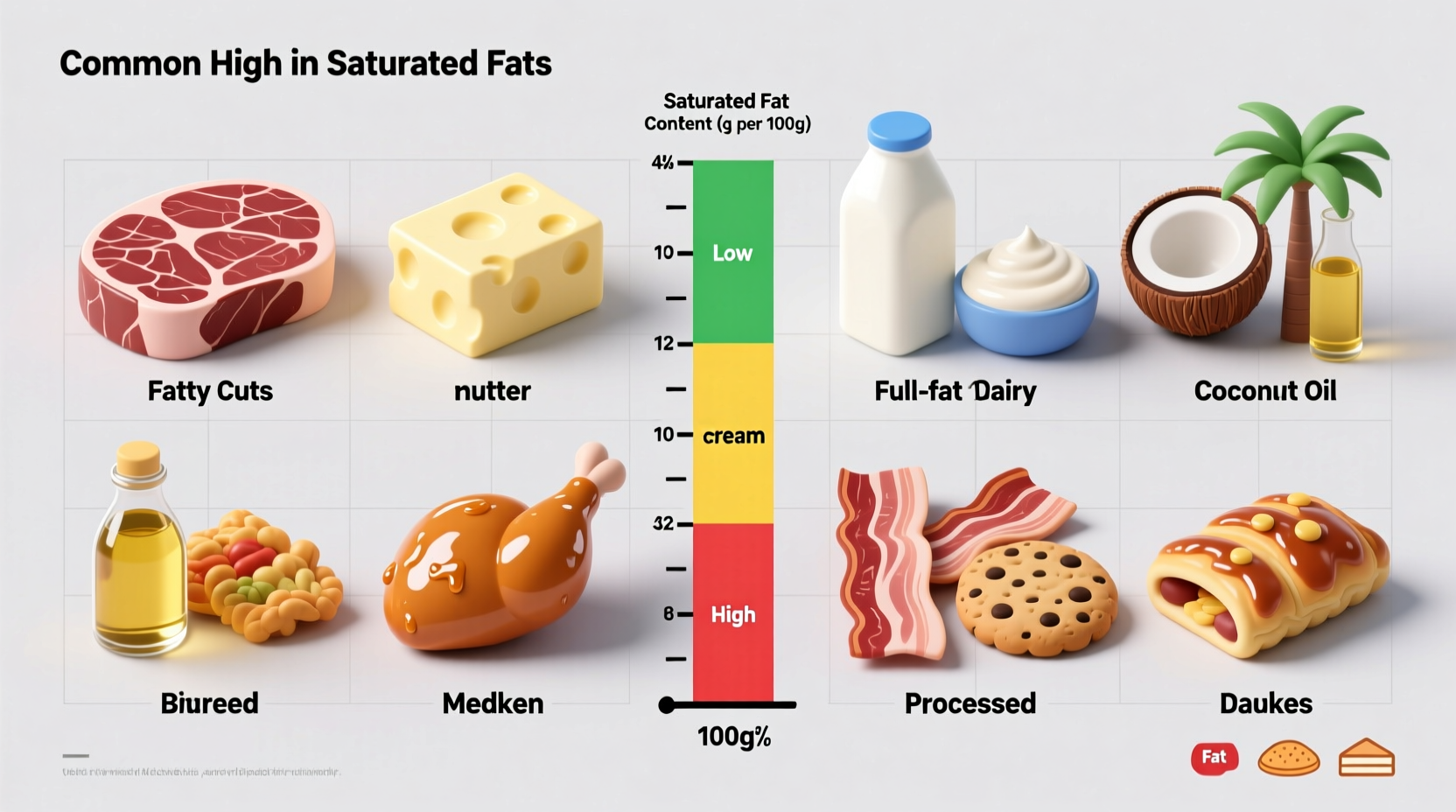Understanding Saturated Fats: What You Need to Know First
When you're trying to make informed dietary choices, knowing exactly which foods contain saturated fats is crucial for managing heart health and overall wellness. This guide cuts through the confusion with scientifically-backed information about saturated fat sources, helping you navigate grocery aisles and restaurant menus with confidence. You'll discover not just which foods have saturated fats, but how much they contain, why it matters, and practical strategies for making balanced choices without feeling deprived.
Animal Products: The Primary Saturated Fat Sources
Animal-based foods represent the most significant sources of saturated fats in typical Western diets. Understanding which cuts and products contain higher levels helps you make strategic substitutions while still enjoying animal proteins.
Fatty cuts of red meat contain particularly high levels of saturated fats. For example, a 3-ounce serving of regular ground beef (80% lean) contains about 5 grams of saturated fat, while the same portion of extra-lean ground beef (95% lean) contains just 1.5 grams. The visible marbling in meats like ribeye steak directly correlates with higher saturated fat content.
| Animal Product | Serving Size | Saturated Fat Content |
|---|---|---|
| Butter | 1 tablespoon | 7.2g |
| Cheddar cheese | 1 ounce | 6g |
| Whole milk | 1 cup | 4.6g |
| Fatty beef (80% lean) | 3 ounces | 5g |
| Chicken with skin | 3 ounces | 1g |
Tropical Oils: Plant-Based Saturated Fat Sources
Not all saturated fats come from animal products. Certain plant-based oils contain high levels of saturated fats, particularly tropical oils. Coconut oil consists of about 90% saturated fat, making it higher in saturated fat than butter (about 63%). Palm oil contains approximately 50% saturated fat. These oils have become increasingly common in processed foods labeled "trans-fat free" as manufacturers seek alternatives to partially hydrogenated oils.
The scientific understanding of tropical oils has evolved significantly. While coconut oil was once demonized along with other saturated fats, recent research suggests its medium-chain triglycerides may metabolize differently than long-chain saturated fats found in animal products. However, major health organizations still recommend limiting coconut oil consumption due to its high saturated fat content.
Processed and Prepared Foods: Hidden Saturated Fat Traps
Many processed foods contain substantial amounts of saturated fats, often hidden behind appealing marketing claims. Baked goods like cookies, cakes, and pastries frequently use butter, palm oil, or coconut oil in their recipes. Fried foods absorb oil during cooking, significantly increasing saturated fat content.
When evaluating common foods with saturated fats, consider these often-overlooked sources:
- Non-dairy creamers (often contain palm oil)
- Plant-based meat alternatives (some use coconut oil for texture)
- Granola and trail mixes with added oils
- Coffee creamers and flavored coffees
- Many "healthy" snack bars

Reading Labels: Your Saturated Fat Detection Toolkit
Nutrition labels provide essential information for identifying which foods contain saturated fats, but you need to know how to interpret them effectively. The % Daily Value for saturated fat is based on a 20g limit per day (for a 2,000 calorie diet), though the American Heart Association recommends aiming for just 13g or less.
When comparing products, look beyond marketing claims like "low cholesterol" which doesn't necessarily mean low in saturated fat. Some products high in saturated fats can still be low in cholesterol since saturated fat and cholesterol are different compounds. Check both the saturated fat line and the ingredient list for sources like palm oil, coconut oil, butter, or lard.
Context Matters: When Saturated Fats Fit in a Balanced Diet
Complete elimination of saturated fats isn't necessary or practical for most people. The key is understanding appropriate context and portion control. Traditional Mediterranean diets, recognized for heart health benefits, include moderate amounts of saturated fats from cheese, yogurt, and occasional meat consumption, balanced with abundant plant foods and healthy fats.
Certain populations may have different considerations. Athletes with high caloric needs might benefit from the dense energy provided by some saturated fat sources. Older adults facing malnutrition risks might need less restrictive approaches. Always consult with a healthcare provider about your individual needs rather than following generic dietary advice.
Practical Swaps for Reducing Saturated Fats
Instead of focusing solely on what to avoid, implement these practical substitutions that maintain flavor while reducing saturated fat intake:
- Replace butter with olive oil or avocado in cooking
- Choose lean cuts of meat and remove visible fat
- Use Greek yogurt instead of sour cream
- Snack on nuts instead of cheese
- Select low-fat or fat-free dairy products
These healthy alternatives to saturated fat foods maintain satisfaction while supporting better cardiovascular health. Remember that flavor comes from herbs, spices, and cooking techniques—not just fat content.
Understanding Evolving Dietary Guidelines
Nutritional science regarding saturated fats has evolved significantly over the past 50 years. In the 1970s, all dietary fats were viewed negatively, leading to the proliferation of low-fat processed foods often high in sugar. Modern research recognizes that not all fats affect health equally, with growing emphasis on replacing saturated fats with unsaturated fats rather than carbohydrates.
The Dietary Guidelines for Americans have gradually refined their recommendations, shifting from simply "reduce all fats" to specifically targeting saturated fat reduction while encouraging healthy fat consumption. This evolution reflects more sophisticated understanding of how different fats impact cholesterol levels and cardiovascular health.
Your Saturated Fat Action Plan
Start implementing these evidence-based strategies today to manage your saturated fat intake effectively:
- Read nutrition labels focusing on saturated fat content
- Limit processed foods which often contain hidden saturated fats
- Incorporate more plant-based meals using beans, lentils, and tofu
- Cook at home where you control the ingredients
- When eating out, ask how dishes are prepared and request modifications
Remember that small, sustainable changes create lasting results. Rather than eliminating all saturated fat sources at once, focus on gradual improvements that fit your lifestyle and cultural food preferences.
Frequently Asked Questions
Are saturated fats always bad for you?
Saturated fats aren't inherently "bad," but should be consumed in moderation. Your body needs some saturated fat for hormone production and nutrient absorption, but excessive intake can raise LDL cholesterol levels. The American Heart Association recommends limiting saturated fats to 5-6% of daily calories for optimal heart health.
How can I identify hidden saturated fats in packaged foods?
Check both the nutrition label and ingredient list. Look for terms like palm oil, coconut oil, hydrogenated oils, butter, lard, or meat fats. Even products labeled "low cholesterol" can be high in saturated fat. Be particularly cautious with baked goods, fried foods, and non-dairy creamers which often contain hidden saturated fats.
What's the difference between saturated and unsaturated fats?
Saturated fats are typically solid at room temperature and primarily come from animal sources and certain tropical oils. They have no double bonds in their chemical structure. Unsaturated fats (monounsaturated and polyunsaturated) are usually liquid at room temperature, come from plant and fish sources, and contain one or more double bonds. Unsaturated fats generally support better heart health when they replace saturated fats in the diet.
Can I eat cheese if I'm watching my saturated fat intake?
Yes, but practice portion control. One ounce of most cheeses contains 4-6 grams of saturated fat. Consider choosing lower-fat options like part-skim mozzarella, feta, or cottage cheese. You can also use strong-flavored cheeses like Parmesan in smaller quantities to get the flavor impact with less saturated fat.
Do all saturated fats affect cholesterol the same way?
Research suggests different saturated fatty acids may have varying effects on cholesterol. For example, stearic acid (found in chocolate and some meats) appears to have a neutral effect on LDL cholesterol, while palmitic and myristic acids (found in palm oil and dairy) tend to raise LDL levels. However, major health organizations still recommend limiting total saturated fat intake regardless of specific fatty acid composition.











 浙公网安备
33010002000092号
浙公网安备
33010002000092号 浙B2-20120091-4
浙B2-20120091-4